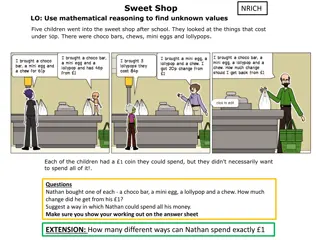Mathematical Problem-Solving Scenarios
Robert is collecting books for donation, a function defines the number of books collected based on days spent. Another function relates the height of a pool with distance walked. Graphs for cost of phone calls on a cruise ship, a function showing rate of change, and a rectangular garden area are analyzed. Lastly, the graph transformation and arrow height model are explored.
Download Presentation

Please find below an Image/Link to download the presentation.
The content on the website is provided AS IS for your information and personal use only. It may not be sold, licensed, or shared on other websites without obtaining consent from the author. Download presentation by click this link. If you encounter any issues during the download, it is possible that the publisher has removed the file from their server.
E N D
Presentation Transcript
Robert is collecting books to donate to the library. The number of books he collects, n, is defined by n = 14d + 21 where d is the number of days he spends collecting books. Part A: What does 14 represent in the context of Robert s book collecting? Part B: What does 21 represent in the context of Robert s book collecting?
The graph of the function h(x) is obtained from the graph of f(x) by shrinking the graph of f(x) vertically by a factor of 5 and reflecting the result over the y-axis. Which of the following equations gives h(x) in terms of f(x)? a. ) ( 5 ) ( x f x h = 1 = ( ) ( ) h x f x b. 5 1 = ( ) ( ) h x f x c. d. = ( ) 5 ( ) h x f x 5
3 0 10 x 1 ( ) = ( ) 1 10 28 h x x x 3 9 28 50 x A person standing at the wall at the shallow end of an empty swimming pool begins walking toward the wall at the deep end of the pool. The height from the bottom to the top of the swimming pool varies depending on the number of feet, x, the person has walked away from the wall at the shallow end. The function h(x) above gives the height, in feet, from the bottom to the top of the pool, where x is measured in feet. Part A: Graph the function h(x) on a coordinate plane. Part B: Describe the change in the height of the pool as the person walks 50 feet from the wall at the shallow end toward the wall at the deep end.
The cost for a phone call on a cruise ship is 65 cents per minute (or part of a minute). Create a graph that shows the total cost, in dollars, for calls between 0 and 10 minutes in length.
The graph of the function g is shown in the coordinate plane. If , and , what are the values of k and c ? a. k = 1/3, c = 2 b. k = 1/3, c = -2 c. k = 3, c = 2 d. k = 3, c = -2 = 2 ( ) f x x = + ( ) ( ) g x kf x c
The area of a rectangular garden is expressed by the function A(x) = x(8 x), where the length of the garden is x feet and the width of the garden is (8 x) feet. Part A: What values of x make sense in the context of the problem? Part B: Graph the function A(x) in the coordinate plane below for the x-values you identified in Part A. Part C: What are the dimensions of the garden that will result in the maximum possible area?
The height above ground, h, of an arrow t seconds after being shot straight up into the air can be modeled by the formula , where t is in seconds and h is in meters. What is the average rate of change of the height, in meters per second, of the arrow over the first three seconds after being shot? Show your work. 5 . 1 = + 9 . 4 2 ( ) 40 h t t t
A grain silo is in the shape of a right circular cylinder with a hemisphere on top. The volume, V, of the silo is given by , where r is the radius of the silo and h is the height of its cylindrical portion. Which of the following is an equivalent form of the volume function that can be used to find a silo s height when its volume and radius are known? V h 3 2 = + 3 2 V r r h 3 2 2 V = 2 = 3 r h r a. b. 2 r 3 r = 2 2 2 r 2 r c. d. = 3 h r h r 3 V 3 V
The graph of the quadratic function g(x) is shown in the coordinate plane, and . Answer each of the following questions about f(x) and g(x). = 3 ( ) f x x Part A: Compute the average rates of change of the two functions on the interval [0, 1]. Compare the two average rates of change. Part B: Compute the average rates of change of the two functions on the interval [1, 2]. Compare the two average rates of change. Part C: Compare the end behavior of the two functions.
A box in the shape of a rectangular prism has a width that is 5 inches greater than the height and a length that is 2 inches greater than the width. Write a polynomial expression in standard form for the volume of the box. Explain the meaning of any variables used.
A stained-glass window design is in the shape of a square with semicircles along each side of the square, as shown above. The length of a side of the square is d. Write a function that gives the area of the window design, A, as a function of d.
An ice cream cone is created by packing ice cream into a wafer in the shape of a right circular cone with height 3r and base radius r, as shown. The ice cream forms a hemisphere with radius r that sits on top of the wafer cone. Which of the following functions gives the volume, V, of ice cream both inside and outside the cone as a function of r ? a. c. 3 V r r = ( ) ( ) ( ) ( ) V r b. d. 3 3 V r = r V r = = r 5 3 5 7 3 7 3 2 6 r 2 6
4 3 2 x + x 3 + x + 10 3 x + 2 Write the expression as where is the quotient with degree 2 and is the remainder. Show your work. 2 x 3 x ( ) 3 x R x + ( ) ( ) Q x + , Q x 2 x + 3 ( ) R x
Given that the factored form of a polynomial function is f(x) = (x + a)(x b)(x + c)(c d), where a, b, c, and d are positive numbers, describe the graph of the function in the coordinate plane including intercepts and end behavior.
Describe each of the following key features of the graph of . Part A: Where does the graph intersect the x-axis? ( )( ) ( )3 2 = + ( ) 3 2 1 f x x x x Part B: Where does the graph intersect the y-axis? Part C: Is the value of f positive or negative for 2<x<3? Part D: Is the graph increasing or decreasing when x>5?
The graph of the fourth-degree polynomial function f(x) is shown in the coordinate plane. Based on the graph, list all linear factors of f(x).
A polynomial function has the following characteristics: the function has exactly 3 real zeros at -3, 1, and 3; the leading coefficient of the polynomial is positive. Sketch a function that meets the characteristics.
At a diving competition, Holly jumps from a springboard that is 3 meters above the surface of the water at time t = 0 seconds. She reaches a maximum height of 4.5 meters above the surface of the water after 0.5 seconds and enters the water 1.5 seconds after jumping. She then sinks to a minimum height of 1.5 meters below the surface of the water 1 second after entering the water and rises back to the surface of the water 2.5 seconds later. Sketch a possible graph of Holly s height above the water, h, from the time she jumps until she rises to the surface of the water. Provide labels and scales for the axes.
When the nth root of a positive number a is written as , what is the value of x ? Fill in the blanks in the partial solution below to explain your answer. a = x a n ( ) n x _____ = a 1 a = _____ 1 = _____ _____ = x
Which of the following is equivalent to ? 1 2 3 4 a b a. b. ab c. d. 2b 3 4 3 4 a 3 ab 2b 3 a
For each of the following statements, put a check mark in the circle to indicate whether the statement is never true, sometimes true, or always true for the operation. Never Sometimes Always When solving equations for real solutions, extraneous solutions occur when a. Squaring both sides of an equation. b. Multiplying both sides of an equation by an expression containing one or more variables. c. Multiplying both sides of an equation by a constant d. Raising both sides of an equation to the power, where m and n are integers. e. Dividing both sides of an equation that has the variable x by x. f. Taking the square root of both sides of an equation.
A certain bacterial culture grows at a rate that triples the number of bacteria every 2 hours. When the first measurement is made (at time t = 0 hours), there are 1,000 bacteria. Part A: Create a graph to show the number of bacteria present for the 4 hours after the measurement. Part B: Interpret the intercepts (if any), in context. As t increases, what happens to the number of bacteria?
Rounded to three decimal places, is approximately equal to 2.322. Use this approximation to solve for x in the equation . Show your work, and round the answer to three decimal places. log2 5 40= x 4























